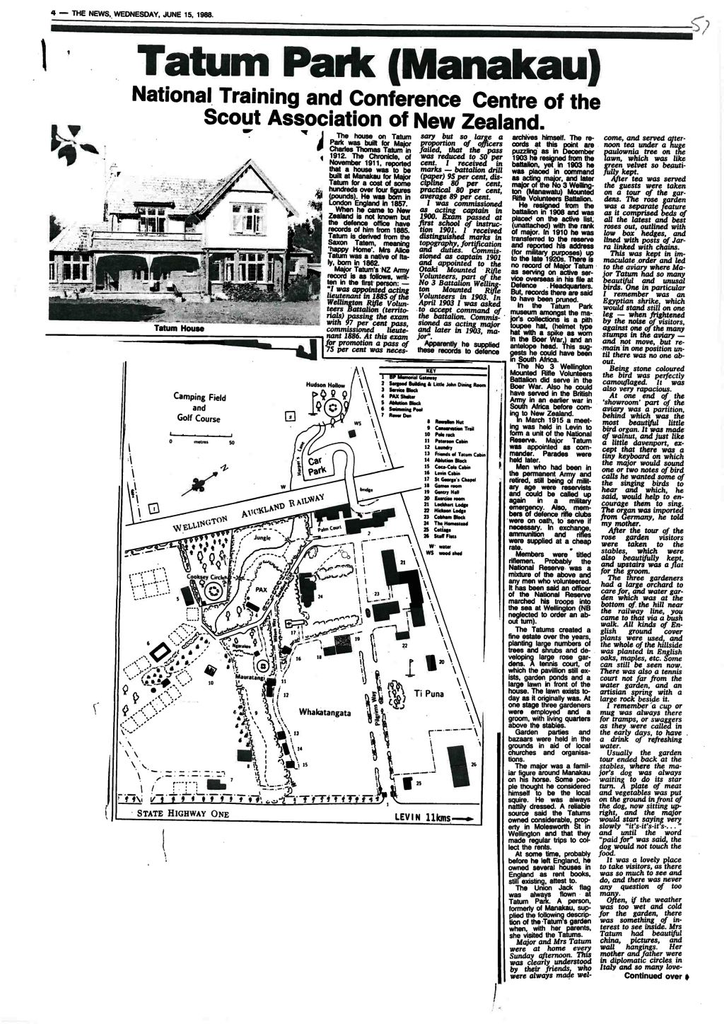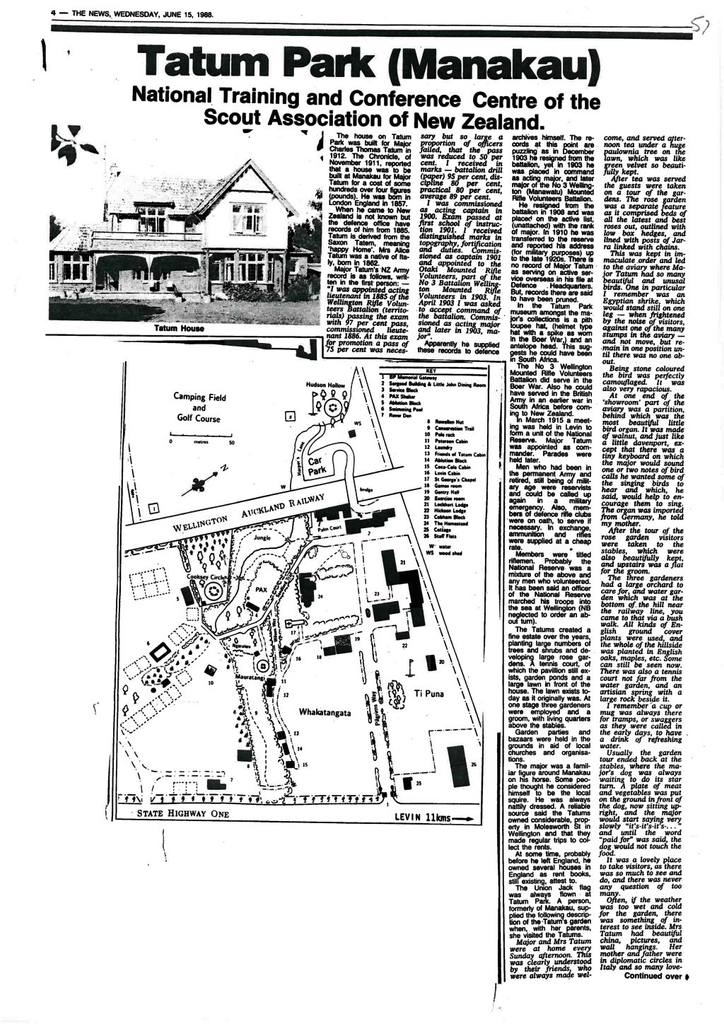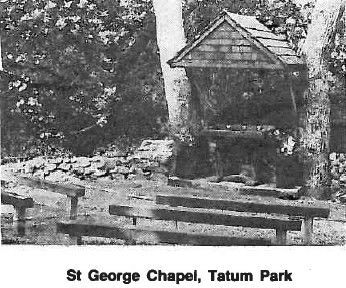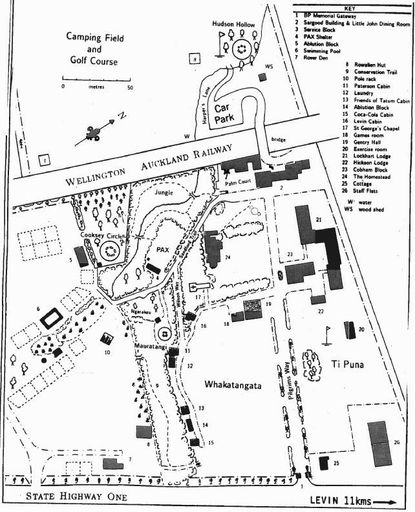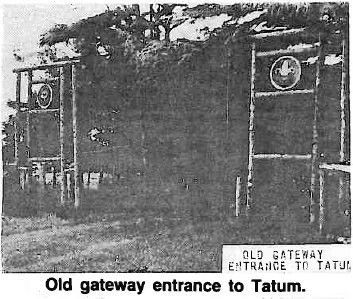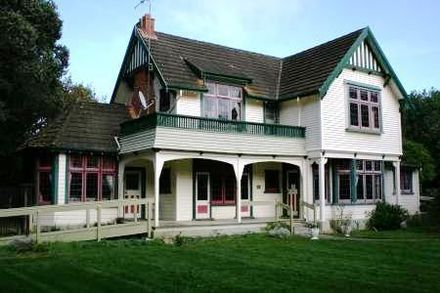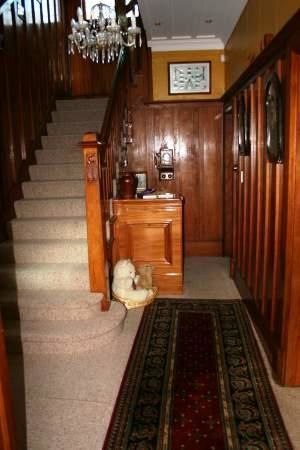Tatum Park (Manakau)
- Description

 The house on Tatum Park was built for Major Charles Thomas Tatum in 1912. The Chronicle, of November 1911, reported that a house was to be built at Manakau for Major Tatum for a cost of some hundreds over four figures (pounds). He was born in London England in 1857.
The house on Tatum Park was built for Major Charles Thomas Tatum in 1912. The Chronicle, of November 1911, reported that a house was to be built at Manakau for Major Tatum for a cost of some hundreds over four figures (pounds). He was born in London England in 1857.When he came to New Zealand is not known but the defence office have records of him from 1885. Tatum is derived from the Saxon Tatem, meaning ‘Happy Home’. Mrs. Alice Tatum was a native of Italy, born in 1862.
Major Tatum’s NZ Army record is as follows, written in the first person:-
“I was appointed acting lieutenant in 1885 of the Wellington Rifle Volunteers Battalion (territorials) passing the exam with 97 per cent pass, commissioned lieutenant 1886. At this exam for promotion a pass of 75 per cent was necessary but so large a proportion of officers failed, that the pass was reduced to 50 per cent. I received in marks – battalion drill (paper) 95 per cent, discipline 80 per cent, practical 80 per cent, average 89 per cent.
I was commissioned as acting captain in 1900. Exam passed at first school of instruction 1901. I received distinguished marks in topography, fortification and duties. Commissioned as captain 1901 and appointed to the Otaki Mounted Rifle Volunteers, part of the No3 Battalion Wellington Mounted Rifle Volunteers in 1903. In April 1903 I was asked to accept command of the battalion. Commissioned as acting major and later in 1903, major”.
Apparently he supplied these records to defence archives himself. The records at this point are puzzling as in December 1903 he resigned from the battalion, yet in 1903 he was placed in command as acting major, and later major of the No 3 Wellington (Manakau) Mounted Rifle Volunteers Battalion.
He resigned from the battalion in 1908 and was placed on the active list, (unattached) with the rank of major. In 1910 he was transferred to the reserve and reported his address (for mainly military purposes) up to the late 1920s. There is no record of Major Tatum as serving on active service overseas in his file at Defence Headquarters. But, records there are said to have been pruned.
In the Tatum Park museum amongst the major’s collections is a pith toupee hat, (helmet type hat with a spike as worn in the Boer War,) and an antelope head. This suggests he could have been in South Africa.
The No 3 Wellington Mounted Rifle Volunteers Battalion did serve in the Boer War. Also he could have served in the British Army in an earlier war in South Africa before coming to New Zealand.
In March 1915 a meeting was held in Levin to form a unit of the National Reserve. Major Tatum was appointed as commander. Parades were held later.
Men who had been in the permanent Army and retired, still being of military age were reservists and could be called up again in a military emergency. Also, members of defence rifle clubs were on oath, to serve if necessary. In exchange, ammunition and rifles were supplied at a cheap rate.
Members were titled riflemen. Probably the National Reserve was a mixture of the above and any men who volunteered. It had been said an officer of the National Reserve marched his troops into the sea at Wellington (NB neglected to order an about turn).
 The Tatums created a fine estate over the years, planting large numbers of trees and shrubs and developing large rose gardens. A tennis court, of which the pavilion still exists, garden ponds and a large lawn in front of the house. The lawn exists today as it originally was. At one stage three gardeners were employed and a groom, with living quarters above the stables.
The Tatums created a fine estate over the years, planting large numbers of trees and shrubs and developing large rose gardens. A tennis court, of which the pavilion still exists, garden ponds and a large lawn in front of the house. The lawn exists today as it originally was. At one stage three gardeners were employed and a groom, with living quarters above the stables. Garden parties and bazaars were held in the grounds in aid of local churches and organisations.
The major was a familiar figure around Manakau on his horse. Some people thought he considered himself to be the local squire. He was always nattily dressed. A reliable source said the Tatums owned considerable property in Molesworth St in Wellington and that they made regular trips to collect the rents.
At some time, probably before he left England, he owned several houses in England as rent books, still existing, attest to.
The Union Jack flag was always flown at Tatum Park. A person, formerly of Manakau, supplied the following description of the Tatum’s garden when, with her parents, she visited the Tatums.
Major and Mrs Tatum were at home every Sunday afternoon. This was clearly understood by their friends, who were always made welcome, and served afternoon tea under a huge paulownia tree on the lawn, which was like green velvet so beautifully kept.
After tea was served the guests were taken on a tour of the gardens. The rose garden was a separate feature as it comprised beds of all the latest and best roses out, outlined with low box hedges, and lined with posts of Jarra linked with chains.
This was kept in immaculate order and led to the aviary where Major Tatum had so many beautiful and unusual birds. One in particular I remember, was an Egyptian shrike, which would stand still on one leg – when frightened by the noise of visitors, against one of the many stumps in the aviary – and not move, but remain in one position until there was no one about.
Being stone coloured the bird was perfectly camouflaged. It was also very rapacious.
At one end of the ‘showroom’ part of the aviary was a partition, behind which was the most beautiful little bird organ. It was made of walnut, and just like a little davenport, except that there was a tiny keyboard on which the major would sound one or two notes of bird calls he wanted some of the singing birds to hear and which, he said would help to encourage them to sing. The organ was imported from Germany, he told my mother.
After the tour of the rose garden, visitors were taken to the stables, which were also beautifully kept, and upstairs was a flat for the groom.
The three gardeners had a large orchard to care for, and water garden which was at the bottom of the hill near the railway line, you came to that via a bush walk. All kinds of English ground cover plants were used, and the whole of the hillside was planted in English oaks, maples, etc. Some can still be seen now. There was also a tennis court not far from the water garden, and an artesian spring with a large rock beside it.
I remember a cup or mug was always there for tramps, or swaggers as they were called in the early days, to have a drink of refreshing water.
Usually the garden tour ended back at the stables, where the major’s dog was always waiting to do its star turn. A plate of meat and vegetables was put on the ground in front of the dog, now sitting upright, and the major would start saying very slowly “it’s-it’s-it’s…” and until the word “paid for” was said, the dog would not touch the food.
It was a lovely place to take visitors, as there was so much to see and do, and there was never any question of too many.
Often, if the weather was too wet and cold for the garden, there was something of interest to see inside. Mrs. Tatum had beautiful china, pictures, and wall hangings. Her mother and father were in diplomatic circles in Italy and so many lovely things in the house were from her mother’s home.
The Hurley family, whose home was where Summerland Gardens are now, were close friends of Mrs. Tatum. She used to go there almost every night during the week, arriving on her bicycle at 7pm. At 8pm, one of the girls made her a cup of tea, and off she would go – a weekly ritual.
Mr. Ken Douglas gave me a good description of the major. He was short and portly, with a round face and rosy cheeks, and a waxed moustache – waxed to a point either side.
Esquire magazine, of many years ago, often featured a major. Mr. Douglas said it seemed to him that the mayor was modelled on Major Tatum.
There seems to be poor memories of Mrs. Tatum except that she was tall.
There was a very good museum on the estate, some of which is in the park museum now.
Mr. Ken Douglas said this is only a shadow of the former collection which he saw when the Tatums were alive. One person said Mrs. Tatum and her sibling family were invited to take anything they wanted from the home, but did not. Apparently, a lot of the Tatums possessions were given away in their later life.
Mr. Douglas was given a Vickers machine gun by the major. This had apparently seen action, as there were two bullet holes in the water jacket and they had been welded. The army collected it in 1940.
In later times, probably from the 1920s when horse vehicles were being displaced by motor vehicles, the Tatums had a car which many people remember, but nobody can remember the brand.
It has been described as very high and square and said to be from a Hupmobile to a Ford.
The Hupmobile had very large wheels which would make the car high, but then, all sedan cars were very high in those days. It is said a chauffeur was employed at one time, but most memories were of the housekeeper, Mrs. Gray, driving with the Tatums as passengers, with Mrs. Tatum dressed in black, sitting tall and straight in the back seat.
In the 1930s, only a cowman-gardener was employed. In 1935, when the Labour party became the Government, the major said if wages went up, the cowman-gardener would have to go. Wages went up, so he did go.
The estate got very overgrown in the 1930s. In 1940 Mr. J. Robin H.Cooksey (Little John) was authorised, by the executive committee of the Scout movement, to explore the country for a property to establish a national training centre for the leadership of Scouts.
He called on Major Tatum who had been on the National Scout Committee, and was still on the National Scout Council. The major indicated that his property would be bequeathed to ‘the Church’, (Anglican).
On a later visit, ‘Little John’ learned that the church thought the property was too neglected and run down, needing great expenditure to restore.
The major then indicated that he would bequeath it to the Scout movement. Two training courses were held in his life time. It was decided to name the property Tatum Park, which greatly pleased the major. He died in 1942 aged 85 and Mrs. Tatum died in 1943, aged 81. They are both buried in the Levin Cemetery.
An immense amount of work was necessary to restore the property and establish training facilities.
Mr. Millar was investigating an overgrown area on the front lawn and found it was a garden pond, full of water, when he fell in it. A band of people over New Zealand formed the Friends of Tatum committee to raise funds, which they did, totalling $20,000 over the years, and also to work on the park. They did a tremendous amount of work during the Christmas holiday periods.
In 1980 the committee was disbanded, although individual volunteers still assist in various ways.
It is jocularly said at Tatum, that the Tatum fortune is buried at the park.
In the will, only the property and some furnishings were bequeathed, there being no mention of other assets.
On a recent Sunday afternoon members of the Horowhenua Historical Society visited Tatum Park.
A video was shown, partly historical and partly on the purpose of the park, as a scout leadership training centre.
National Training and Conference Centre of the Scout Association of New Zealand.
We toured the museum consisting of the Tatum collection of items from around the world and of scouting memorabilia.
The memorial gateway was opened in 1962, being dedicated to Lord Baden-Powell, the founder of the Scout movement.


The long drive, lined with trees is the Pilgrims Way and leads down past the original house, (now the manager’s home), with its very large lawn with shrubs and trees on its perimeter, to the main administration building. This is Sargood building, built in 1967, being named for Sargood Trust who have, for many years, given large donations to the park.
The ground floor contains the camp office, guest lounge, Lucas library and the museum, housing Tatum relics and scouting memorabilia. Also there is the trading post selling ice-cream and souvenirs.
Attached also, is the ‘Little John’ dining hall, built in 1964.
In 1969, 1972, and 1980, the hall and kitchen were extended. This part of the Sargood building was financed by many donors and the Friends of Tatum committee.
We were now on the Sundford Trail heading south. This was named for Major F.W. Sundford, the first training commissioner in New Zealand. On the left is a double garden pond with some wild duck feathers, apparently a refuge at times. Palm Court was on the right, being the service block, consisting of a grocery store, which services the kitchen and campers, and the gear store and workshop.
Further on, to the right, was the jungle, an area of native bush, through which is a pleasant walk. Going by a very large tree it is mainly original bush. Then on to Pax, (latin for peace), originally the tennis court, with the, still existing, pavilion. Pax, was named for Lord Baden-Powell’s house in Bently, Shropshire.
This is used for training courses, for games, sessions and meetings. It is surrounded by trees and is sheltered, even in a strong southerly and is a very peaceful area.
We crossed Pax, and moved down a path, through a corner of the bush, over the creek, and came to the Cooksey Circle, named after Mr. J.R.H.Cooksey (Little John). It is now the main campfire circle and is surrounded by native trees that have been planted in recent years. After going through another patch of bush, we came to the camping fields, which have been converted into a caravan park, with the usual amenities. The swimming pool here also, was built in 1961 from finance provided by the Friends of Tatum.
The camping fields are used by scouts camping at Tatum.
Directly south of the swimming pool, dividing the camping fields is McLeod’s Copse, named after a scout, Donald McLeod. After his death his parents donated the trees for the copse.
In 1980 a barbecue was built in this sheltered and shady area.
Further on, close to the highway, is the Rover Den – Whaka Whare. This was financed and built by the Rovers of New Zealand in 1947. Later it was developed further, and is now used as a base for leaders running troop camps, being used also as a family cabin.
Nearby is Rowallan Hall. Originally opened by, the then chief scout of the commonwealth, Lord Rowallan. The hall was moved to its present site in 1970 and is used by families staying at the caravan park and by scouts camping at Tatum, as a storm hut.
Nearby is the Conservation Trail, formed in 1969. It is a very pleasant walk and leads east into Whakatangata.
Turning back up to the Sandford Trail, on the right is Ngarakau (the place of trees), and it is used as a session circle. Just a few yards on, a path leads up to Mauratangi – The Quiet Place of Seat of Learning, - a small campfire circle, used for campfires on courses.
A few steps back up the Sandford Trail is Wilson Way, named after Miss Nancy (Akela) Wilson, who was, for many years, the Headquarters Commissioner for Cubs.
Through a gateway is Whakatangata – the place were men are made. In it are four tourist cabins, the cost of each was from various donors. These are Paterson cabin, Friends of Tatum cabin, Coca-Cola cabin, Levin cabin, and an ablution block.
 In the south west corner is a memorial arch, which was constructed by a keen King's Scout named Sharman, with a pen knife. As a pilot he was killed in the Battle of Britain. His father presented the arch, which took the boy two years to carve, to Tatum, where it forms the entrance to St George’s Chapel – outdoor and lit at night. It is consecrated and entirely interdenominational.
In the south west corner is a memorial arch, which was constructed by a keen King's Scout named Sharman, with a pen knife. As a pilot he was killed in the Battle of Britain. His father presented the arch, which took the boy two years to carve, to Tatum, where it forms the entrance to St George’s Chapel – outdoor and lit at night. It is consecrated and entirely interdenominational.On from the arch is Gentry Hall, opened by Major General Sir William Gentry in 1973. He served the scout association in several executive capacities from 1965 to 1973.
The building comprises a main meeting hall, a games room, and several auxillary rooms. It is possible to have two training courses/conferences running concurrently in it.
Across Pilgrims Way is Te Pura – The Old One or Grandfather – named after Mr James Grose, known as Te Puna. He was national president when Tatum was taken over.
Lodges
On the highway frontage is a cottage, built in 1950 by voluntary labour, being a staff house. There are two staff flats nearby which were built in 1975 and 1979. Further west is an exercise room, built in 1885. Lockhart Lodge was originally opened in 1961 and was capable of housing 48 people in rooms with four bunks. It was named for Major General L.K. Lockhart who, while chief commissioner, did much to develop Tatum. In later additions 34 rooms were added. It is now able to accommodate 64 people in either double, or single rooms, self-contained with laundry facilities.
Hickson Lodge comprises two executive suites for the use of course directors. It was named for, and opened by Mr. F.E.L. Hickson who was closely associated with Tatum during the years he served as national treasurer.
Cobham block was opened in 1961 by Lord Cobham when he was Governor-General. During 1970 the ground floor was converted into two syndicate rooms and offices for use by course leader. Two more syndicate rooms were later built, giving full conference facilities on the first floor.
An overhead bridge, over the railway, was built by the New Zealand Army. This leads to the back part of the park where there is parking for vehicles.
Down Harper’s Lane – camp director, 1951-1958 – on a terrace, is a six hole golf course also used as a camping field. A campfire circle, known as Hudson’s Hollow – named for Mr G.A.Hudson, camp director 1958-1965 – is on the high ground.
Much of the park has trees growing in clumps, copses, avenue and lines, both in natives and exotics, some obviously original from when the house was built.
The many tree areas provide a sheltered and tranquil atmosphere for the training areas and buildings, either amongst or close to them. The St George’s Chapel, set in a patch of trees and built simply with natural timber, creates a peaceful and tranquil glade.
Training in leadership for the various Scout categories is given in courses, with accommodation in many forms available.
Trainee’s families may also have accommodation. Scout groups from all over New Zealand also camp at the park for periods.
Various types of functions such as conferences, weddings and dinners etc; are catered for with accommodation, if necessary, available.
The guest lounge, with an outside area with tables and seating, is available for small functions.
Meals are available in the dining room by appointment.
Visitors are welcome to view the area, provided they contact the administration office first.
The various types of accommodation are available for the general public, subject to vacancies.
As I have not seen through the house, only a brief description can be given. It is two storeyed. Originally, the master bedroom occupied the whole of the east side of the first floor. It has in later years been divided into two bedrooms, with two other original bedrooms on the same level.
Also originally here was a maid’s room.
The major’s office is now the children’s playroom.
The original Tatums dining table is in the dining room. Tiles have now replaced the original shingles on the roof but the spouting is of the original copper.
The lower half of the exterior walls is of the original rusticating weatherboard, but the upper seems as if it has been replaced by the modern weatherboard.
There is still some of the chain fence that once surrounded the rose gardens near the house.
Photographs provided by NZ Scout Assoc. headquarters.The News, June 15, 1988
Identification
- Date
- June 15, 1988
Taxonomy
- Community Tags

